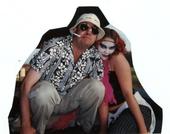Part Two: Dawn of the Dead
Dawn of the Dead, which was made in 1978, picked up where Night left off: a world thrown into chaos at the hands of the living dead. Instead of dealing with issues such as racism and a crumbling family unit, Romero has, instead, used gentrification, consumerism with a hint of morality as his main subtext. Consumerism has a more prominent role in this film, but Romero used gentrification as his set up of the film.
Dawn follows the plight of four people on the run from the carnivorous horde plaguing the city of Philadelphia. There are two couples here: Stephen, a helicopter pilot for WGON, and Fran, a producer for WGON. They are lovers who were planning to start a life together. The other two are Peter and Roger who worked as SWAT for the city. Dawn opens with a television studio, you guessed it, as chaotic as what is going on outside of the studio. They are filming a “talk show” trying to figure out what is happening and how to stop it. What is interesting is that morality of the situation seemed to be the hot button issue and why the disaster had spun out of control. One can parallel this to modern day media where morality seems to be the justification to why the world is where it is today. Another aspect in the opening scene that also parallels today’s media is confusion that arises over a catastrophic event. One example of confusion in today’s media is 9/11 and the events following. It’s not to say that Romero was foreshadowing how today’s media handles situations in the world and it’s events. Like Night and Dawn who tries to explain the phenomena with explanations of voodoo to an outer space virus whereas today’s media tries to put into context of world conflicts as everything from opposition to western freedom to the gay lifestyle. One fine example of this choice in morality comes from the station manager who has kept up an old list of stations that serve people trying to seek shelter from the living dead even though some of the stations have closed for whatever reason. Fran tells the board operator to put up an updated list.
Here is the dialogue between the two:
Fran: Are you willing to murder people by sending them to places that have closed down.
Mr. Berman: Every minute that list isn’t up, people won’t watch us, they’ll tune out.
Mr. Berman has the mindset that the station is still going for ratings and not that it is just an emergency broadcast station. This isn’t too far from today’s media which has the mindset that they are all about the ratings and not what they are there for.
We then go into the second scene where the SWAT is stationed around a public housing high-rise waiting out a standoff between leaders of the housing high-rise and the negotiators. The whole scene in the apartment building is a metaphor for gentrification at that time. The military acting as the housing authority pushing its residence into central areas of the city much like it was back in the late seventies and early eighties. In one scene, there was an explanation for why the tenants kept its dead in the basement.
“They still believe there’s a respect in dying,” says Peter. The dying could be construed as the gentrification of all major U.S. cities at the time where the lower income families were being forced into the cities while the upper class were moving away from the cities.
After awhile, the four land on the roof of an indoor mall. It was the late seventies and the indoor mall was a new concept in the lives of consumers. The mall would be a key character in DOTD. For the rest of the film, all characters would represent an aspect of the consumer culture of America.
“What are they doing? Why do they come here?” Fran asks Steven.
“Some kind of instinct, a memory. What they used to do. This was an important place in their lives.”
Steven’s line invokes a subtext that is prevalent in the rest of the film; that the zombies are representatives of the consumer collective. Romero says on the commentary found on the theatrical cut of the film that, “It is a satire on consumerism. We want all this stuff. It isn’t enough and somebody wants it too.”
Tom Savini, who was the head make-up artist, stuntman, and plays Blades at the end, reinforces Romero’s comment about the consumers and how the commentary still holds up to the present, “go to a shopping mall today and there are zombies walking around lulled by the muzak into shopping.”
Even of the close-ups on the zombies, you see their wide-eyes staring ahead turning slowly trudgingly toward the hall of shops ahead. There is even a hare chrisna zombie that subconsciously reflect a sort of religious rite of being in the mall.
Subscribe to:
Post Comments (Atom)

No comments:
Post a Comment